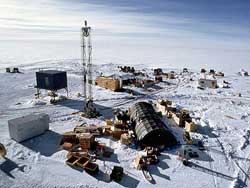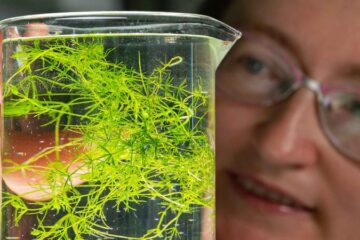Latest News

South Pole telescope follows trail of neutrinos into deepest reaches of the universe
Researchers can now pinpoint direction of elusive subatomic particles key to understanding black holes, other cosmic events
A unique telescope buried in Antarctic ice promises unparalleled insight into such extraordinary phenomena as colliding black holes, gamma-ray bursts, the violent cores of distant galaxies and the wreckage of exploded stars.
An international team of physicists and astronomers, which includes UC Irvine researchers, report that the AMANDA telescope is cap

More people are getting sick from eating fresh fruits
Salmonella, E. coli, shigellosis, hepatitis A, and Norwalk — these food-borne diseases can produce symptoms that run from the mild to life-threatening. The young and old are particularly vulnerable and while consumption of beef and poultry have been the most common sources of such infections, fresh fruits and vegetables are being increasingly implicated in such outbreaks. So much so, that plant disease scientists are now taking a closer look at this issue.
“Historically, human pathogens l

Research reveals how strep bacterium evades immune system
Like a well-trained soldier with honed survival skills, the common bacterium, Group A Streptococcus (GAS), sometimes can endure battle with our inborn (innate) immune system and cause widespread disease. By investigating the ability of combat-ready white blood cells (WBCs) to ingest and kill GAS, researchers have discovered new insights into how this disease-causing bacteria can evade destruction by the immune system. The research is being published this week in the Online Early Edition of the Procee

New protein will help fight inflammation
A joint research project by scientists in Cardiff, UK, has developed a new protein, which could end the suffering of thousands.
The research, by scientists at Cardiff University and the University of Wales College of Medicine (UWCM), and funded mainly by the Wellcome Trust, is designed to tackle the problem of chronic inflammation – which can lead to serious disorders such as rheumatoid arthritis and bacterial peritonitis.
Now a two-year development programme is getting un

Puzzle solved on how influenza builds its infectious seeds
By solving a long-standing puzzle about how the influenza virus assembles its genetic contents into infectious particles that enable the virus to spread from cell to cell, scientists have opened a new gateway to a better understanding of one of the world’s most virulent diseases.
This insight into the genetic workings that underpin infection by flu, reported today (January 27, 2003) in the Proceedings of the National Academy of Sciences (PNAS), provides not only a better basic understa

Drug-resistant seizures often take years to develop
While about 80 percent of people with epilepsy gain significant relief from drug therapy, the remaining 20 percent have seizures that cannot be controlled by medications. Many of these people have a particular type of epilepsy called partial epilepsy. A new study shows that people with partial epilepsy often have seizures controlled by medications for years before their seizures become drug-resistant. The study also found that periods when seizures stopped for a year or more are common in these patie











